
South Australian Medical Heritage Society Inc
Website for the Virtual Museum
Home
Coming meetings
Past meetings
About the Society
Main Galleries
Medicine
Surgery
Anaesthesia
X-rays
Hospitals,other organisations
Individuals of note
Small Galleries
Ethnic medicine
- Aboriginal
- Chinese
- Mediterran
Electrogustometer
Acknowledgement: We are grateful to Dr. M. Anne Hamilton-Bruce, Principal Medical Scientist in the Department of Neurology and Jan Hooper, Nursing Director of the Medical Division of The Queen Elizabeth Hospital, Adelaide , for helpful information and allowing us to photograph the device. Dr. Peter Last kindly showed us his own self-made gustometer.
The OED mentions the word “gust” on two occasions one relates to a nautical term pertaining to a sudden blast of wind. The other is derived from latin: “gustare” to taste and meter ‘to measure”. Thus gustometer is used to measure the ability to taste.
The US Food and Drug Administration Centre for Devices and Radiological Health defines it as ”A battery powered device that consists of two electrodes that are intended to be placed on both sides of the tongue at different taste centres and that provides a galvanic stimulus resulting in taste sensation"
In the two illustrated devices direct, (galvanic) current is provided by batteries. In both devices the current can be increased until a recordable threshold, a tingling sensation, is reached.
The gustometers are used by neurologists or ENT and other specialists to detect any threshold differences between the left and right side of the tongue as may occur after a stroke, in diabetic patients or in cranial nerve lesions.
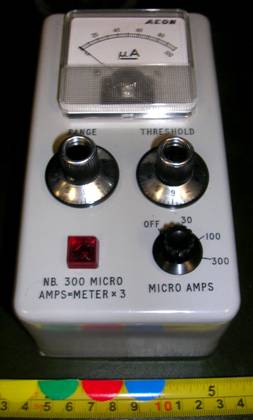 The electric gustometer: The current from the batteries is measured in microamps and can be varied (lower right). If the current is increased until a tingling sensation is reached (threshold knob upper right of the panel). The microamps reading on both sides of the tongue are recorded and any differences suggest a lesion.
The electric gustometer: The current from the batteries is measured in microamps and can be varied (lower right). If the current is increased until a tingling sensation is reached (threshold knob upper right of the panel). The microamps reading on both sides of the tongue are recorded and any differences suggest a lesion.
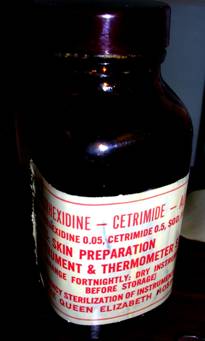 A bottle of cetrimide is used to sterilise the probes. Alcohol or other disinfectants may have an anaesthetic effect.
A bottle of cetrimide is used to sterilise the probes. Alcohol or other disinfectants may have an anaesthetic effect.
 The gustometer, the tongue probe, and cetrimide. The other terminal is rounded and flat and is held to the forehead by an elastic band.
The gustometer, the tongue probe, and cetrimide. The other terminal is rounded and flat and is held to the forehead by an elastic band.
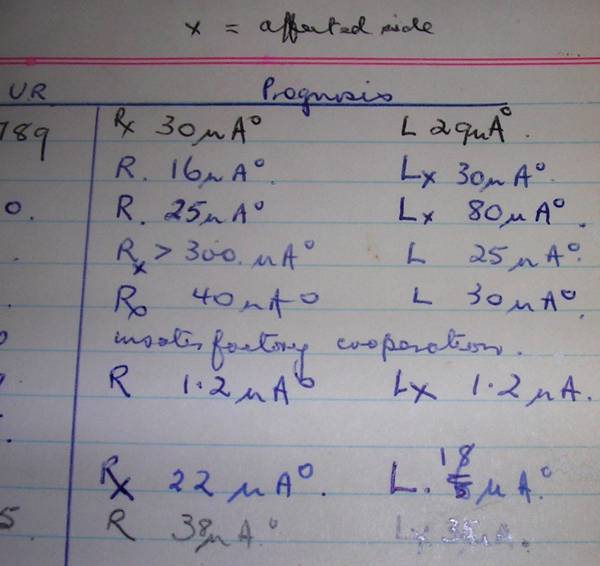
Sample of recordings from nine patients obtained by the gustometer. The intensity is in microamps and the sides are indicated as Right or Left. The site of the lesion is indicated by an x. In 3 of the nine patients the threshold to reach a tingling sensation was higher on the affected side. Measurements in the other six patients with lesions were not significant. One did not cooperate and the other record is not clear. More recently gustometer probes have been coupled with digital electro-encephalograms in animals and man using saline and other stimulants in order to identify sites of discrete brain lesions.
Dr. Peter Last’s Gustometer
Dr. Peter Last is an eminent South Australian Physician, whose early interest was neurology. He is a born teacher and his demonstration of neurological examination using common household items such as match boxes, coins, pins and other household items is unique. He performed the first renal dialysis at TQEH and worked as a physician at both the RAH, TQEH and RGH. His attachment with the Health Commission involved development of SA country hospitals and the Julia Farr Centre (formerly named the “Home for Incurables”). His gustometer is self -designed.

A pupilometer: A normal ophthalmoscope. The metal disc was attached by Dr.Last and measured the size of the pupil.
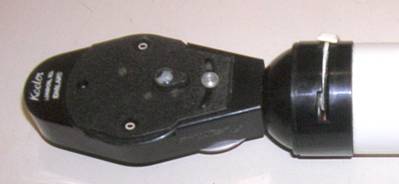 The reverse side of the ophthalmoscope: The white line at the right shows a rheostat which can increase the current and thus increases the light intensity of the light globe.
The reverse side of the ophthalmoscope: The white line at the right shows a rheostat which can increase the current and thus increases the light intensity of the light globe.
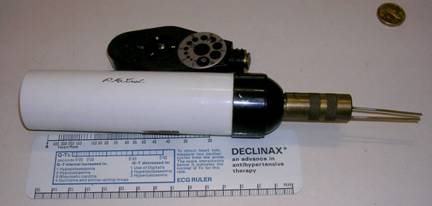 The gustometer: The ophthalmometer head is removed and the gustometer probe is attached.
The gustometer: The ophthalmometer head is removed and the gustometer probe is attached.
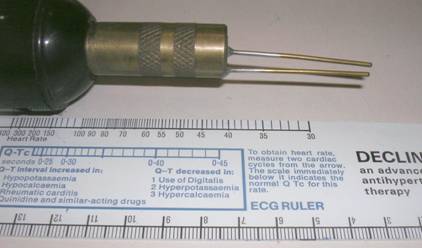 Close up view of the two electrodes of the gustometer. The rheostat of the ophthalmometer can change the current intensity, and the two sides of the tongue can be compared for the presence or absence of tingling
Close up view of the two electrodes of the gustometer. The rheostat of the ophthalmometer can change the current intensity, and the two sides of the tongue can be compared for the presence or absence of tingling
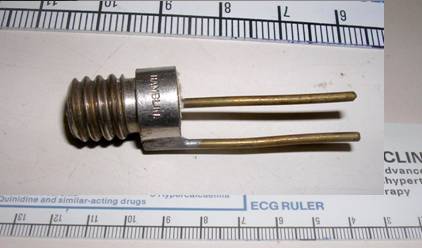 A variation of the gustometer. It can replace the bulb in an ordinary torch.
A variation of the gustometer. It can replace the bulb in an ordinary torch.